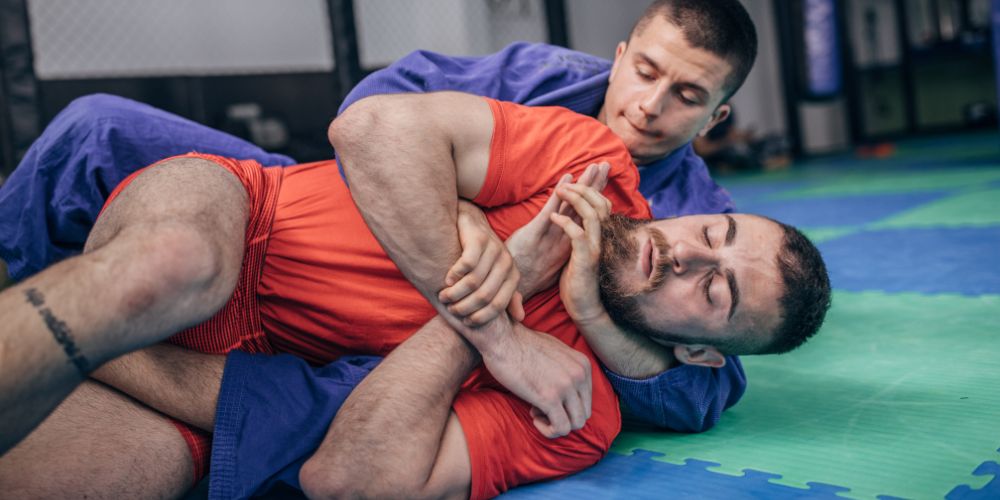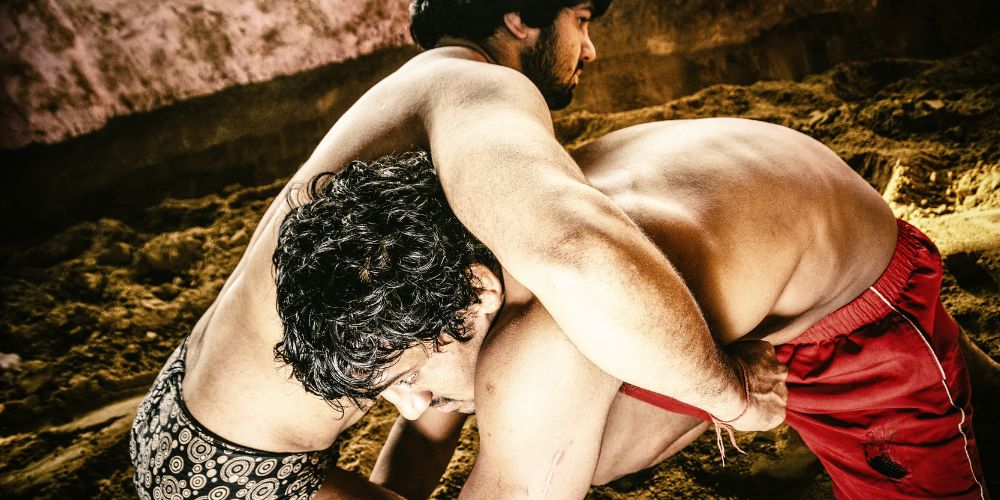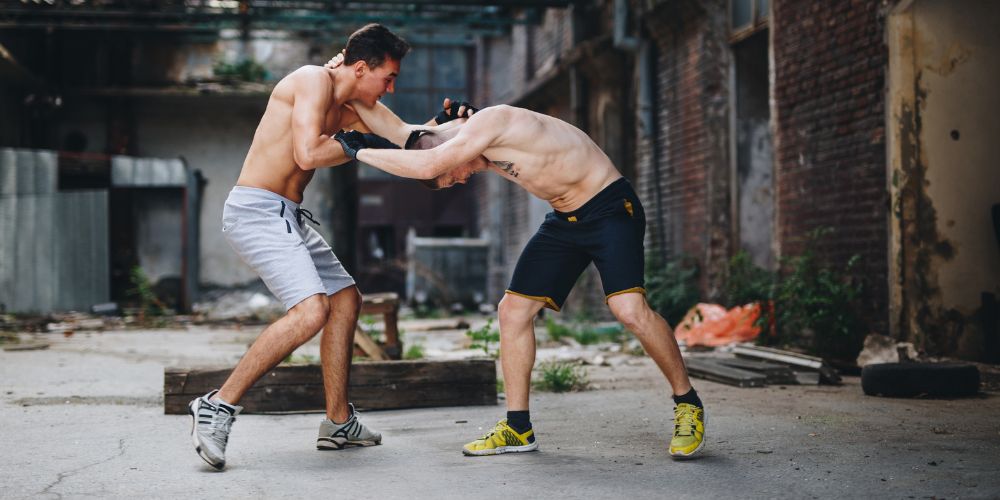Wrestling has numerous forms and encapsulates countless styles, but today’s term is mainly used for the two styles contested in the Olympics. Sambo is also a form of wrestling but with some distinct differences. Do you know what they are?
Wrestling is a grappling sport where the goal is to pin both shoulders of the opponent to the mat without intentionally hurting them. Sambo is a Russian combat sport where submissions can be used in addition to throws and takedowns like the ones used in wrestling.
A key difference is that Olympic wrestling is a loose style where clothing cannot be grabbed, while Sambo is a jacket style of wrestling.
There are many more similarities and differences between the two styles, and if you have the option to choose between them, it’s worth knowing all the details to make an informed choice.
What Is Sambo?
Sambo is a Russian national sport, first created in the 1930s in the Soviet Union as a system for hand-to-hand combat for the servicemen of the Red Army. The name is an acronym for “self-defense without weapons” in Russian.
It was created by the independent individual efforts of Viktor Spiridonov and Vasili Oshchepkov, who mixed techniques from different martial arts to create a more effective system.
Judo became the primary backbone of the new system, but Sambo also implemented techniques from catch wrestling and various other martial arts. Sambo was accepted as the official combat sport of the USSR in 1938.
Sambo has multiple variations, which are different from each other. The most prevalent version is called sports Sambo, which strongly resembles traditional Judo. It is a grappling-only sport that allows a variety of takedowns, trips, and throws, as well as submissions.

How to Dominate Every Fight with Raw, Explosive Power No One Can Match
Discover the underground blueprint that has quietly turned MMA hopefuls into legends, using nothing but sheer, brute force and bulletproof conditioning techniques.
The other main version of the Russian sport is Combat Sambo. Initially, Combat Sambo was developed and used solely by the military and some special police branches, but by the end of the 1980s, it was gradually opened to the general population.
In addition to the grappling, combat Sambo also has a significant striking aspect. The striking is almost entirely free and allows every strike possible, including head butts and elbows.
Combat sambo strongly resembles MMA by mixing nearly unlimited striking and grappling, but the rules differ from those of mixed martial arts, and matches have a different dynamic.
Sambo has been made popular worldwide by legendary MMA fighters like Fedor Emelianenko and Khabib Nurmagomedov. Both are combat Sambo world champions and two of the greatest MMA fighters of all time, attributing their success in the cage to Sambo.
What Is Wrestling?
Wrestling is one of the oldest forms of unarmed combat. Every single major culture in history has practiced some form of wrestling. There are records of competitive wrestling dating back to 3000BC, and it was a very prestigious and important activity in Ancient Greece and Rome.
There are countless variations of wrestling, including Sambo and Judo. All of which are united to ground an opponent in a particular position or hold him there.
In modern times, the term wrestling is used mainly for the Olympic version of the sport, which includes Greco-Roman and freestyle. Greco-Roman allows wrestling only from the waist up and bans using the legs for tips, while in freestyle, the entire body can be used.
Freestyle was derived from catch as catch can, which features many painful holds and locks, used either to elicit a submission or force the opponent into a bad position.
In the early 19th and 20th centuries, Catch became more of a professional and entertainment endeavor, while freestyle was created as an amateur sport by removing all the holds.
Today, the two Olympic styles are the most popular grappling styles, and nearly every country competes at international events. Wrestling’s specialization in takedowns and control makes it a valuable and necessary skill set for MMA and submission grappling.
Key Differences Between Sambo & Wrestling

Since Combat sambo includes striking, a more suitable comparison is between wrestling and sports sambo, which include only grappling. Let’s see where they differ and where they are alike.
Rules
Wrestling matches are divided into two periods of three minutes each, with a 30-second break in between. The competition area is an open mat 9 meters in diameter.
The primary objective of a match is to pin both shoulders of the opponent on the mat for a brief moment, which leads to immediate victory by “fall.”
If there is no pin, the winner is determined on points. Wrestlers earn points for offensive moves like takedowns and reversals and for exposing the opponent’s back to the ground.
Sambo matches are contested on an 8-meter mat for five minutes. In sports sambo, there are multiple ways to score points and win a match, including throws, hold-downs, and submissions.
Throwing the opponent on his back earns the most points, and if the attacker remains standing, he wins the match immediately. The match is also over if one competitor has an 8-point advantage.
In addition to throws and takedowns, holding and controlling the opponent on the ground also scores points.
Another method of scoring and winning in Sambo is applying a legal submission. Straight arm and leg locks are allowed in sports sambo, while chokes and most other submissions are not. In Combat Sambo, there are almost no restricted holds.
Equipment
Wrestlers wear a form-fitting one-piece uniform called a singlet. The singlet aims to replicate wrestling naked without actually being naked. Wrestlers also wear flexible, lightweight shoes that provide excellent mat grip.
Sambo practitioners wear a jacket called a kurtka, similar to a judo gi. The uniform presents a key difference between the styles because you can grip and use the kurtka for takedowns, control, and defense. One competitor wears a red uniform while the other must wear a blue one.
Sambists also wear tight shorts and shoes, very similar to wrestling shoes.
Techniques
Freestyle wrestling allows the whole body to take the opponent to the ground. The most common takedown techniques are double and single-leg takedowns, but they are far from the only ones.
Upper body control using underhooks and overhooks is vital, as is the battle for hand control. Various techniques like the hip toss and fireman’s carry are used to take the opponent to the ground and leg trips.
On the mat, the attacking wrestler aims to control and pin his opponent through various techniques, while the defending wrestler does his best to escape or reverse the position.
Sambo has a plethora of takedown techniques. Wrestling-style takedowns, as are judo throws and sweeps with or without using the jacket, are common.
Sports sambo also allows the use of submissions, although not all kinds. Chokes and neck and spine cranks are off-limits, but the arm and leg lock game in Sambo is strong and includes a lot of straight arm and leg locks.
Competitive Landscape
Like most other Olympic sports, wrestling is extremely popular, and most countries have government-backed wrestling programs and national teams.
These countries have well-developed competition circuits running tournaments at levels, starting from kids and leading to national teams that compete at international events like continental championships, World championships, and the ultimate proving grounds- the Olympic Games.
In the USA, wrestling is popular among school and college students. The style used there has slightly different rules than freestyle wrestling and is called Folkstyle or collegiate wrestling.
Sambo is present in a lot less places than wrestling. As a Russian martial, it’s generally only found in old Soviet block countries with frequent competitions at all levels.
Some sambo clubs are outside Russia and its neighbors, but there is no competition circuit.
Sambo vs. Wrestling For Self Defense

Sambo is better suited for self-defense due to its more liberal ruleset. It was initially designed as a self-defense system and served the purpose admirably.
Even sports Sambo, without any striking, teaches devastating takedowns, including clothing, which can be effective in many real-life situations.
Many sambists also practice combat sambo, which may be the best martial art for self-defense.
Using strikes with each body part, wrestling, and all available submissions makes it highly effective for self-defense. This is not a surprise since it is a combat system designed for the military.
With that said, wrestling can also teach you valuable self-defense skills. Wrestlers are tough and athletic and can control where a fight takes place with their takedown skills.
The intensity and mindset of wrestling also prepare practitioners for real-life conflicts. The downside of wrestling is the lack of striking, submissions, and fight-ending capabilities.
Sambo vs. Wrestling For MMA
Sports Sambo may be better for MMA because it has more tools, including many wrestling techniques.
If we include Combat Sambo in the discussion, things become different because it’s the closest thing to MMA without being MMA. Some of the greatest cage fighters of all time, Fedor Emelianenko and Khabib Nurmagomedov are combat sambo world champions.
But there is a crucial factor in wrestling that is hard to replicate elsewhere. As an Olympic sport, wrestling is prestigious all around the world.
The more popular a sport is, the more money and respect there is, and the more people want to get to the top, so to win a major title in wrestling, you have to defeat a vast talent pool.
Wrestling is infamous for its intense and rigorous competitions, which instill a unique mentality in high-caliber wrestlers.
It has been proven repeatedly that wrestling champions become some of the toughest MMA fighters. Think about the success of wrestlers like Henry Cejudo, Daniel Cormier, Randy Couture, and Cain Velazquez had in the cage.
It is difficult to determine if Sambo or wrestling is a better base for MMA, given the number of great champions both have produced, so they are equal.
Does Sambo Have Wrestling?

Unlike its forefather, Judo, where leg grabs are banned, Sambo allows attacking the legs for a takedown. This means wrestling takedowns like the single and double leg are also commonly used in Sambo, making wrestling an essential component of Sambo.
Sambo vs. Wrestling: Who Would Win?
Sambo should have the upper hand in a fight without rules based on its variety. While strikers have a hard time defending a takedown, sambists are also grapplers but with a more diverse skill set.
Of course, in a pure wrestling match, wrestling easily wins. Wrestlers are also usually stronger, faster, and more durable by the nature of their sport, and because the use of clothing in Sambo lowers the need to use raw physical power to win.
Should You Learn Sambo or Wrestling?
Sambo and wrestling have proven to be incredible martial arts and combat sports. The skills and physical and mental qualities they develop are worth mountains of gold. If you are looking for a more diverse skillset to use in MMA and self-defense, Sambo is probably the better choice.
But if you are looking for a professional career path, wrestling has a lot more to offer. Even in countries with well-developed Sambo, such as Russia and the former Soviet bloc, being a wrestling champion is one of the highest sporting honors you can achieve.
Olympic and world champion wrestlers become celebrities and earn significantly more money and respect.
So, the choice will be tricky if you have both Sambo and wrestling available to train. But you can’t go wrong in either case.

